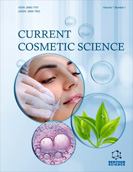Abstract
The majority of sunscreen cosmetics are emulsions or creams. However, formulations that use lipid nanoparticles as the delivery vehicle for sunscreen chemicals may offer benefits in terms of skin retention, enhancement of penetration through the epidermal layer, and Ultraviolet (UV) absorption and scattering. Solid lipid nanoparticles (SLN) and nanostructured lipid carriers (NLC) have been investigated to create sunscreen products with low or medium UV protection. SLN and NLC have a wide range of characteristics and have been proven to effectively control the entry of actives showing UV protection activity through the skin. They have no hazardous effects; therefore, they can be employed safely in dermatological and cosmetic preparations to obtain different traits. When utilized as vehicles for molecular sunscreens, lipid nanoparticles showed a synergistic impact of UV scattering. The ability to minimize the concentration of the molecular sunscreen, its potential adverse effects, and the expenses of formulating pricey sunscreens are all advantages derived from these studies. The review discusses some research on how lipid nanoparticles have been encapsulating sunscreen agents. Exposure to sunlight is a key element in the aetiology of the gradual undesired changes in the skin look and physiology caused by UV rays present in the sunshine; hence evaluating sunscreen activity is an essential aspect of the cosmetic business. The author will also address some of the in vitro and in vivo assessments of sunscreens.
Keywords: In vitro and in vivo evaluation
Graphical Abstract
[http://dx.doi.org/10.7324/JAPS.2015.50611]
[http://dx.doi.org/10.1111/jocd.12504] [PMID: 29441672]
[http://dx.doi.org/10.1016/j.ijpharm.2016.03.018] [PMID: 26976501]
[http://dx.doi.org/10.1111/ics.12165] [PMID: 25256657]
[http://dx.doi.org/10.1111/j.1365-2133.1997.tb03709.x] [PMID: 9274634]
[http://dx.doi.org/10.1111/jocd.14004] [PMID: 33583116]
[http://dx.doi.org/10.1016/j.xphs.2021.08.020] [PMID: 34425132]
[PMID: 27099487]
[http://dx.doi.org/10.1002/jps.22271] [PMID: 20575052]
[http://dx.doi.org/10.1111/j.1468-2494.2008.00433.x] [PMID: 18452432]
[http://dx.doi.org/10.1016/j.ijpharm.2008.10.003] [PMID: 18992314]
[http://dx.doi.org/10.1046/j.1467-2494.2001.00087.x] [PMID: 18498463]
[http://dx.doi.org/10.1016/j.ijbiomac.2005.05.003] [PMID: 16005509]
[http://dx.doi.org/10.1016/j.ijpharm.2005.02.005] [PMID: 15848010]
[http://dx.doi.org/10.1016/j.colsurfb.2009.03.032] [PMID: 19410436]
[PMID: 23093904]
[http://dx.doi.org/10.1016/j.heliyon.2020.e03831] [PMID: 32395645]
[http://dx.doi.org/10.1111/j.1468-2494.2007.00410.x] [PMID: 18489386]
[http://dx.doi.org/10.1016/j.ejpb.2017.04.008] [PMID: 28411056]
[http://dx.doi.org/10.1208/s12249-020-01821-x] [PMID: 33073311]
[http://dx.doi.org/10.1016/j.colsurfb.2021.111786] [PMID: 33984613]
[http://dx.doi.org/10.1111/j.1751-1097.1979.tb07090.x] [PMID: 441130]
[http://dx.doi.org/10.3390/cosmetics7010014]
[http://dx.doi.org/10.1016/j.bjp.2019.02.003]
[http://dx.doi.org/10.1111/jocd.12470] [PMID: 29226503]
















